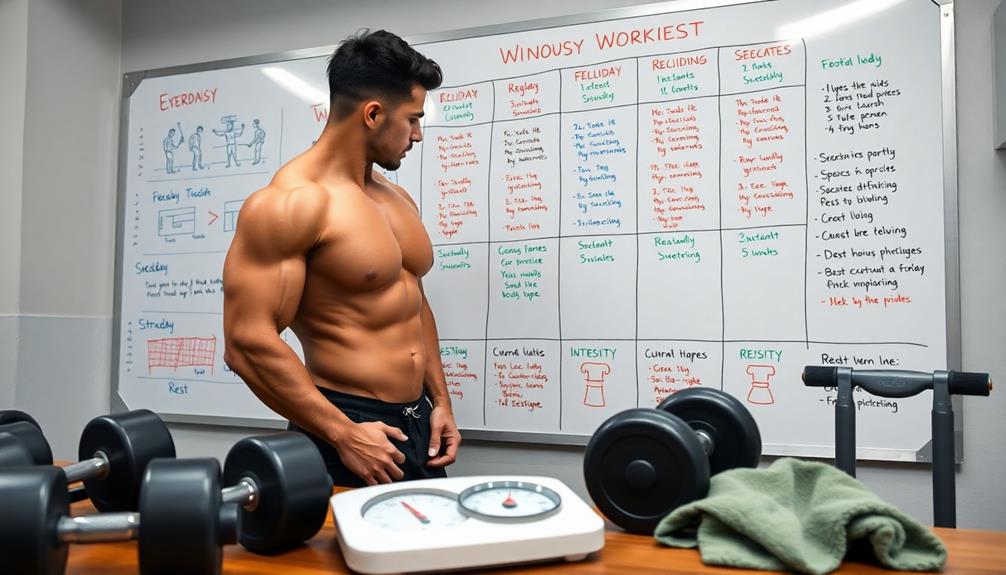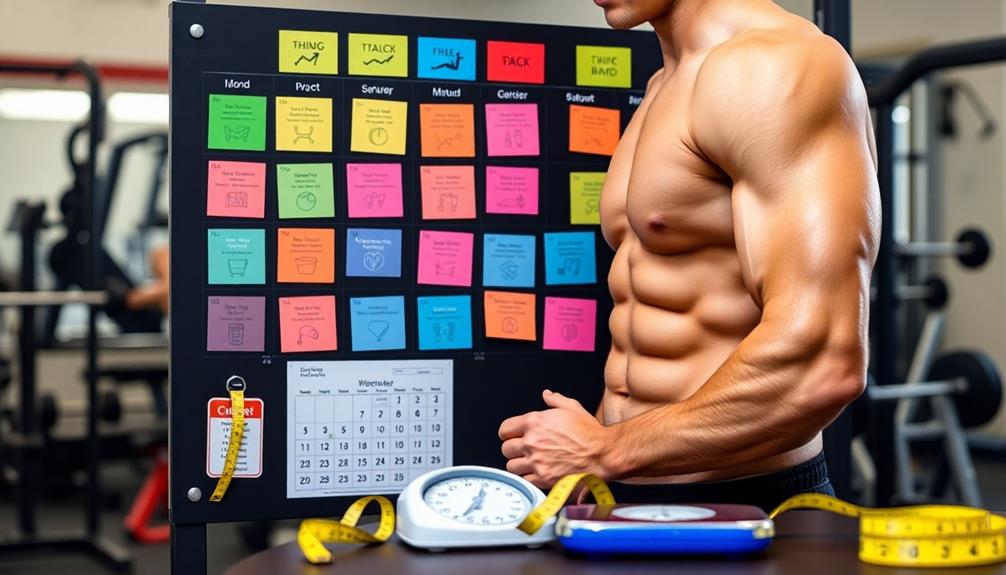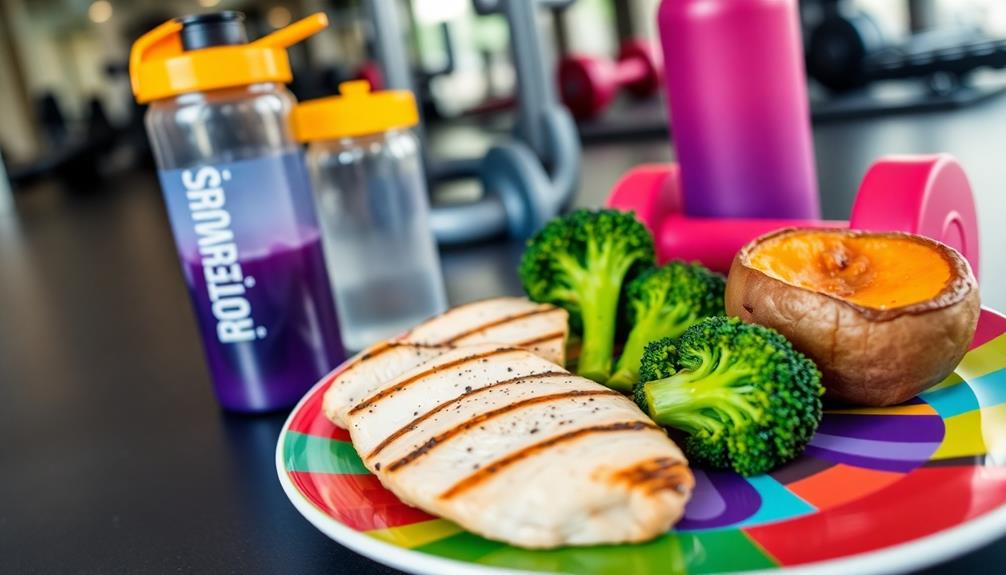To structure an effective cutting workout split for fat loss, focus on creating a balanced plan that combines strength training and cardio. Aim for 3-4 strength sessions per week, targeting different muscle groups each day. Incorporate 2-3 high-intensity interval training (HIIT) sessions to boost fat burning, and add 1-2 low-intensity cardio sessions for recovery. Include compound exercises like squats and deadlifts, and use progressive overload techniques to maintain muscle while cutting. Balance your workouts with proper nutrition, creating a calorie deficit through diet and exercise. Remember to schedule 1-2 rest days to prevent burnout. By following these principles, you'll be well on your way to achieving your fat loss goals.
Core Insight
- Plan 3-4 strength training sessions weekly, focusing on compound exercises like squats and deadlifts.
- Include 2-3 HIIT sessions for increased fat burning and metabolic boost.
- Balance cardio and strength training to burn calories while maintaining muscle mass.
- Create a calorie deficit through a combination of diet and exercise.
- Incorporate progressive overload and exercise variety to avoid plateaus and continue making progress.
Understanding Cutting Workout Splits

A cutting workout split is a great way to lose fat and keep muscle. It's an exercise plan that targets different muscle groups throughout the week.
To get the most out of a cutting split, you need to balance weight training with cardio. Focus on exercises that work several muscles at once, like squats and deadlifts. These burn more calories and boost your metabolism. Make sure to eat enough protein and create a calorie deficit through diet and exercise. Taking keto supplements along with your workouts may help you burn more fat by putting your body in a state of ketosis.
Your cutting split should fit your schedule and goals. Some common options are full-body workouts, upper/lower body splits, or push/pull/legs routines. The most important thing is to stick with it over time.
Principles of Fat Loss Training

Getting lean and cutting fat boils down to a few key things. You've got to burn more calories than you eat. High-intensity workouts and lifting weights help a lot. Cardio is good too. And of course, you need to dial in your diet.
Here's a simple workout plan to get you started:
| Day | Workout Type | Duration |
|---|---|---|
| Monday | Weights | 45-60 min |
| Tuesday | HIIT | 30 min |
| Wednesday | Rest | – |
| Thursday | Weights | 45-60 min |
| Friday | Cardio | 45 min |
Designing Your Weekly Schedule

Designing an effective weekly schedule for fat loss requires balancing various workouts and rest days. Start by planning 3-4 strength training sessions that focus on exercises working multiple muscles at once. Space these sessions out during the week to allow for proper recovery. Adding natural fat burners can support your weight loss efforts without causing sleep issues or jitters, helping control appetite and boost fat metabolism when paired with regular exercise.
Fit in 2-3 HIIT sessions, either on their own or combined with strength training. These workouts rev up your metabolism and increase fat burning.
Include 1-2 low-intensity cardio sessions for recovery and extra calorie burn. Schedule 1-2 rest days to let your body recover and avoid burnout.
Tailor this plan to your own schedule and fitness level. Stay consistent with your workouts while paying attention to your body's signals.
Balancing Cardio and Strength Training

Balancing cardio and strength training is key to losing fat effectively. Both types of exercise work together to help you reach your goals. Strength training keeps your muscles strong and boosts your metabolism. Cardio burns calories and keeps your heart healthy. Here's an easy plan to balance your workouts each week:
- Monday: Work your upper body with weights and do high-intensity interval training (HIIT) for cardio. Spend about an hour total.
- Tuesday: Focus on your lower body muscles and do steady-state cardio, like jogging or cycling, for 45 minutes.
- Wednesday: Take a rest day, but still do a light 30-minute walk to stay active.
- Thursday: Do a full-body strength workout and HIIT cardio for 60 minutes.
- Friday: Train your upper body again and do 45 minutes of steady-state cardio.
Try to do strength training 3-4 times a week and cardio 3-5 times a week. Adjust this based on your goals and how your body feels. Make sure to give yourself enough rest to recover between workouts.
Optimal Exercise Selection

Choosing the right exercises is key to losing fat and keeping muscle. Focus on exercises that work multiple muscles at once, like squats, deadlifts, bench presses, and pull-ups. These exercises burn more calories and help your body make more hormones that help you lose fat and keep muscle. Adding fat burners to these exercises can help you cut fat faster and reach your goals sooner.
Add high-intensity interval training (HIIT) to your routine. This can include exercises like burpees, mountain climbers, and jump rope. HIIT is great for burning fat and getting your heart in better shape in a short amount of time.
Don't forget to include exercises that target specific muscles. This will help you keep your muscle size and shape. Examples include bicep curls, tricep extensions, and calf raises.
Make sure to change up your exercises from time to time to avoid plateaus and keep your workouts challenging. This will help you keep making progress in your fat loss journey.
Progressive Overload for Cutting

Progressive overload is crucial for cutting fat, not just building muscle. When you're eating fewer calories than usual, you need to keep your muscles challenged so you don't lose muscle mass as you lose fat. Supplements like CLA and L-Carnitine may help you burn more fat during your cut while you continue making progress in your workouts.
Try these three simple ways to use progressive overload during a cut:
- Lift heavier weights over time
- Do more reps in each set
- Take shorter rest breaks between sets
Nutrition's Role in Workout Splits

Nutrition plays a key role in your cutting workout plan. To lose fat, you need to eat fewer calories than you burn. But it's important to eat enough protein to keep your muscles strong. Aim for 1.6-2.2 grams of protein per kilogram of body weight each day. Fat burners without stimulants can help you lose weight without making it hard to sleep or causing jitters. They can control appetite and boost fat burning when used with a healthy diet and exercise.
Try to time your meals around your workouts for the best results. Eat a balanced meal with carbs and protein 2-3 hours before training. Have a snack high in protein within 30 minutes after your workout. Remember to drink plenty of water all day, especially when cutting calories.
Recovery and Rest Days

Rest days are just as crucial as workout days when cutting. They let your body recover, fix muscles, and recharge. If you don't rest enough, you might overtrain. This can make you tired, perform worse, and get injured. When planning your cutting workout routine, think about taking supplements to help lose fat and keep energy up on rest days.
To get the most out of rest days during a cut:
- Take 1-2 rest days a week, based on how intense your workouts are
- Do easy things like walking or stretching to get blood moving
- Prioritize good sleep to help muscles recover and balance hormones
It's tempting to go hard every day, but remember that progress happens when you recover. Muscles grow and change when resting, not mid-workout. By adding strategic rest days to your cutting plan, you'll lose fat and keep muscle more effectively.
Adjusting Your Split Over Time

As you progress through your cutting phase, it's important to adjust your workout split. This helps you keep seeing results and avoid plateaus. Your body gets used to exercise routines, so what worked at first may be less effective as you get leaner. Think about using supplements to support your cutting goals and boost your workout performance.
Keep a close eye on your progress and be ready to switch things up. If your fat loss starts to slow down, try working out more often or harder. You could add an extra training day or do more compound exercises. But if you're feeling tired or overtrained, cut back on your workout volume or take an extra rest day.
Feel free to try out different split structures. You could go from a body part split to an upper/lower split, or try a push/pull/legs routine. The important thing is to pay attention to your body and adjust as needed. Make sure you're always challenging yourself while still letting your body recover.
Frequently Asked Questions
How Long Should a Cutting Phase Last?
You should aim for a cutting phase lasting 8-16 weeks. It'll depend on your starting body fat percentage and goals. Don't rush; losing 1-2 pounds per week is ideal. Adjust your timeline based on progress and how you're feeling.
Can I Build Muscle While on a Cutting Workout Split?
While cutting, you can still build some muscle, especially if you're new to lifting. Focus on maintaining high protein intake, lifting heavy, and keeping your calorie deficit moderate. You'll likely see more muscle preservation than significant gains.
Should I Take Supplements During My Cutting Phase?
You don't necessarily need supplements during your cutting phase. Focus on a balanced diet first. However, protein powder, multivitamins, and omega-3s can be beneficial. Always consult a healthcare professional before starting any supplement regimen.
How Do Hormones Affect Fat Loss During a Cutting Workout Split?
Your hormones play a pivotal role in fat loss. They'll influence your metabolism, appetite, and fat storage. Optimizing hormones like testosterone, cortisol, and thyroid can enhance your cutting results. Focus on sleep, stress management, and balanced nutrition.
Is It Necessary to Change My Workout Split When Transitioning From Bulking?
You'll likely need to adjust your workout split when switching from bulking to cutting. Focus on maintaining muscle while reducing calories. Increase cardio and adjust your lifting routine to support fat loss while preserving strength gains.

